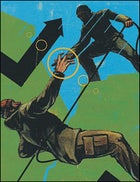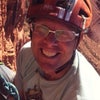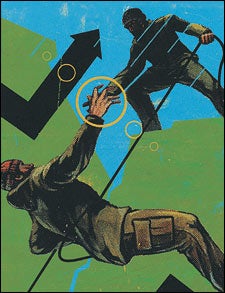BRYAN BORNHOLDT AND I WERE traversing the airy spine of the Bighorn Mountains, leaping block to block. We had ascended 1,500 feet before dawn began saturating the rock and the sky and the trout-shaped clouds with a deep pink. The first two summits along the ridgeline were already behind us. Only six more to go.

Bryan had been uncharacteristically lagging behind. He only passed me once, almost wearily, as I stopped to take some photographs. When he was 200 yards ahead, I yelled for him to turn around. It was windy on the ridge and I had to shout again before he stopped and struck the classic mountaineer’s pose, a heroic silhouette against the immense, jagged skyline.
After the trip, back home, I found myself studying this snapshot. Odd how we instinctively trust the veracity of a photograph. The sharpness and clarity suggest reliability. A photo, at least on the surface, which is all there is in a photo, appears to tell the truth. Of course, in actuality, a photo reveals only a paper-thin slice of a single moment. It’s no more truthful than a bullet before it is fired or a match before it is lit. In the next second, everything could be different.
When I caught up with Bryan, he was gingerly backstepping along a knife-edge arĂŞte. The exposure was startling: a 2,000-foot drop to either side. Where I stood the rock was still granite, but beyond a crevasselike fissure, the ridge abruptly changed to crumbling volcanic tuff. Bryan was out there trying to keep his balance. With each backward step, the stone disintegrated beneath his feet and gushed down in sick rock slides on both faces. His legs seemed unsure. At one point he pirouetted 180 degrees, wobbled violently, steadied himself like a tightrope walker, then raised his head and looked across at me. I was jolted. There was horror in his eyes, and his bearded face was a gray mask. But I could do nothing. We were unroped.
It is unsettling to discover a layer of fragile, unsound rock concealed between deep strata of solid granite, but not uncommon. In the geological life of mountains, all the internal pressures—the constant bending and twisting and subducting—are complex, and under extreme circumstances, weaknesses will inevitably come to the surface.
By the time Bryan stepped back onto solid rock, he was badly shaken. I’d never seen him like this before. He was the last person I could imagine losing it.
“I don’t know what to do,” he said.
I moved carefully out along the deteriorating ridge, going past where Bryan had turned back. “Well,” I yelled into the wind, “there’s nothing out here to tie a rope to.” Then the rock began collapsing under my feet like a sand castle and I quickly retreated.
It was an impasse. Our once-sturdy backbone of granite had suddenly become spineless. We were forced to change plans.
THE GOAL HAD BEEN an enchainment—the scaling of several mountains or walls in succession. One of the most famous enchainments in the Alps is the ascent, one after another, of the Croz Spur, the north face of the Matterhorn, and the north face of the Eiger (although the purity of this alpine triple crown is spoiled by the use of a helicopter to get from peak to peak). In Yosemite, tearing up the northwest face of Half Dome and then The Nose on El Capitan is a notoriously difficult enchainment. The Cathedral Traverse in the Tetons (Teewinot, Mount Owen, the Grand) and the Bugaboo Traverse in British Columbia (the Howsers, Bugaboo, Snowpatch, the Pigeons) are two other magnificent linkups.
Enchainments are the ultramarathons of mountaineering. They are a traditional expression of an excess of mountain exuberance, that half-bacchanalian, half-masochistic joy that can be found in staying high and moving with speed and agility and confidence through difficult, perilous terrain.
Many enchainments are completed in 24 to 48 hours. In most cases, the climbers have done all the individual routes multiple times. But not always. Three years ago Steve Bechtel told me of an enchainment he and fellow Wyoming climber Mike Lilygren did sight unseen over 32 hours, trailhead to trailhead, in the Bighorn Mountains of northern Wyoming in July 1999. The five-peak enchainment encompassed Black Tooth, Woolsey, the Gargoyle, Innominate, and the whaleback of Cloud Peak.
“Utterly exhausting,” Bechtel enthused. “Most of it was moderate class 5 with bad rockfall, although we did put up a dicey 5.11, which would have been beautiful in climbing shoes.” (Steve did the whole enchainment in approach shoes.) “Yeah, it was great fun,” Lilygren agreed. “The bivy was one of the coldest, most miserable nights of my life.”
I’d never been to the Bighorns, but this sounded perfect. Given that an enchain- ment requires the legs and lungs of a cyclist, the honed technical skills of a traditional rock climber, and an alpinist’s ability to sanguinely endure sleep deprivation and vile weather, you might think it hard to find a partner. Naw. I knew just the guy: Bryan Bornholdt, 42, math professor, father, devout Christian, fitness Nazi. Bryan lives in Fruita, Colorado, so he can bike and climb 12 months a year. He once cycled 330 miles north to south through Colorado in 24 hours. He climbed the west face of El Cap in a day. In Zion National Park he climbed Desert Shield in a day, and Fang Wall and Lunar Ecstacy and a dozen others. He was renowned for being relentless. I have friends who’ve quit doing things with him because, they say, “he’s way too intense.” I e-mailed Bryan.
“I’m in!” he replied. “I like the idea of going ridiculously light. Far too often we engage in things that we feel comfortable trying. Why not go for broke?”
WE PACKED AT the trailhead after spending eight hours driving, the last two on an absurdly bone-jarring four-wheel-drive track.
Rain jacket and bivy sack, nuts and fruit, ropes and climbing hardware, all jammed into a daypack—and away we went, walking fast and talking big.
Our plan was a hypertrophic extension of Bechtel and Lilygren’s achievement. We wanted to start farther north and west of the central Bighorn spires they had traversed, at the very tip of the spine, and do every summit, round or sharp, in a southward arc—eight peaks in all.
We set out at 5 p.m. and in four hours had covered more than 12 miles. Bryan had a stomach ailment. It could have been nerves; it could have been something he ate; either way, he discounted it.
“Don’t worry,” he said, coming out of the trees for the fifth time.
At twilight we scrambled up smooth slabs to a tiny cirque beside a black tarn. There was heavy cloud cover. A seam of purple light slipped momentarily between the full-bellied clouds and the earth; then it was black. It was going to rain.
Rain is the scourge of rock climbing, corroding self-confidence in a sport in which you already push the boundaries of your own insecurity. Wet rock is treacherously slippery, adding degrees of difficulty and peril. And then there’s lightning. Hanging on a wall in the sky gives you no place to hide. If God is so inclined, you’re an easy target. The only shield between you and a bolt of lightning is prayer. Which, as we all know, sometimes gets answered with “No!” in thunder.
I had gotten the ominous forecast off the Web that morning: thunderstorms. It would have been best to wait for blue skies, but our summer schedules, like everybody else’s, were packed. This was the only slot where our free time overlapped.
When it started to rain, we wormed into our bivy sacks, said good night, and pulled the drawstrings so tight that only our noses stuck out. We’d try for a little sleep and see if the storm passed.
A bivy sack is roughly as comfortable to sleep in as a garbage bag. Alpine meadows appear soft as a featherbed until you lie down and discover pointy rocks inside those lovely green tufts. Bryan and I got maybe four hours of shut-eye before the cold woke us. For two hours we tossed and turned, then got up, packed up, and started moving, somewhere around 4 a.m. The rocks were still wet, even coated with verglas in a few places, but it wasn’t raining.
Bryan, who was no longer in intestinal distress, fell behind right from the start. On past trips I’d hardly been able to keep up with him. The summer before, we’d done the Cruise route in the Black Canyon of the Gunnison in half the guidebook time. The year before we’d humped onto the east face of Longs Peak and then swung up Pervertical Sanctuary as fast as baboons.
I waited for him on the first summit, following the bright speck of his headlamp. It was almost dawn by the time he arrived.
“What’s up?” I was trying to sound cheerful.
“Nothing,” said Bryan, feigning good spirits himself.
We cut down into a rocky col and started up the second peak. On top I drank water and ate a handful of nuts. Bryan arrived looking hammered.
“I think it’s altitude,” I said.
“Could be,” said Bryan.
Neither of us believed this.
An hour later we reached the section of ridge that unexpectedly metamorphosed from good granite to rotten, dissolving volcanic junk. In Bryan’s ashen face I saw the end of our trip—and I responded with more denial. Something was clearly wrong with my partner, but I was hell-bent on doing the enchainment, one way or another. I suggested we descend an intermediate ridge, cut across the western cirque, climb the northwest buttress of Cloud Peak, circle around, and complete the entire enchainment in the reverse direction. This would turn our curving one-way traverse into a giant figure eight. It’s almost always a bad sign when Plan B is more complicated than Plan A—it reveals desperateness.
“How ’bout it?” I asked.
“OK,” Bryan replied woodenly.
We descended the intermediate ridge. At the base I waited for Bryan for more than an hour before he dropped his pack beside me and slumped into the grass.
“How you feeling?”
“All right,” he replied. He said he’d taken a fall in the talus. “Really scared me, Mark.”
Bryan was having one of those days we all dread, when for some inexplicable reason the fire is out. You feel murky and vulnerable and unfocused inside. A mysterious anxiety has worn a hole into your ordinarily strong heart, and your will is bleeding out. You become anxious, and this in turn causes you to become diffident, which consequently kills your body’s alacrity. Suddenly you are numb-footed and clumsy. Neither your mind nor your muscles are working properly, your spirit is spent, and there’s almost nothing you can do about it.
The mysterious neurological flow that on other trips had given Bryan the ability to climb almost effortlessly had vanished. He was a shell of himself. I knew how he felt. It had happened to me. Unfortunately, I was feeling fit as a fiddle.
We ate dried peaches, swigged iodized alpine water, and stared up at the pyramid-shaped northwest buttress of Cloud Peak. It wasn’t even 10 a.m., but already the clouds were boiling back in.
“You want to do it, Bryan?”
“Of course.” He answered with such profound abstraction that it was as if he wasn’t even there.
“We don’t have to.”
“No, I want to.”
“You’re sure?”
“Yup.”
I tried to convince myself that he was being sincere, but I knew he was only saying that he wanted to continue because he didn’t want to disappoint me. We were partners. Linked together. All I had to do was have the courage to call it quits. All I had to do was let go of my selfish expectations.
“Let’s do it,” I said.
THE 1,200-FOOT NORTHWEST buttress of Cloud Peak had never been climbed. We had no idea if it was even possible. We had no information about a potential route or the quality of the rock or the options for descent. I feared that this was part of what was unnerving Bryan. He was used to climbing hard, but almost always on well-traveled lines, with tons of beta, detailed topos, and bombproof anchors. The route on Cloud Peak was terra incognita.
We traversed along the base, then diagonaled up ledges. The face grew increasingly steep, and we roped up at the base of a vertical crack. I eagerly took the first lead, trying to contrive enthusiasm for both of us.
“It’s easy going up here,” I shouted down.
As on all our climbs together, we would swing leads. Bryan led the second pitch methodically but not slowly. I was hopeful. I led the third pitch and Bryan the fourth. Standing huddled together on a three-inch belay ledge, I soaked up the beautiful, sweeping vastness below us while intentionally ignoring the black thunderclouds overhead.
“How’re you doing, Bryan?” I touched him on the shoulder.
“I don’t know.”
Somehow I’d imagined he was getting better.
“Mark, I really love my family.” He was watching the thunderclouds.
“I know you do.”
“I promised Deb I’d be home tomorrow.”
“We could go down,” I said. It was the last thing I wanted, and he knew it.
“No.”
As I started the fifth pitch, it began to rain. The wetter the rock got, the more focused I became. My mind closed in on the task. It was like narrowing the beam of a flashlight. I cut out everything on earth but the rock right in front of me and the move I was about to make. At the top of the pitch I exploded with a wail of relief and pride.
The pitch was technically below Bryan’s ability, but when he reached the belay he looked white.
“That…” He was gasping. “That was insane.”
It was still raining. We still had an unknown number of difficult pitches above us with an unknown descent after that.
“We can bail,” I said.
Bryan didn’t answer. He didn’t look like himself. His eyes were deeply lined and his cheeks drawn, as if he were in pain. “It’s my lead,” he whispered, his voice as thin and strained as that of a man condemned to the gallows.
“I’ll lead,” I volunteered.
“Would you? Would you do that?”
Bryan had never given up a lead in his life. His will had completely dissolved.
THE NEXT MORNING, after another shivering bivouac, we made the 20-mile march out and Bryan told me about the time he was hit by lightning. He’d been in Colorado, on a wall 400 feet off the deck. He’d seen the small, dark cloud but didn’t think much of it. All he remembers is an earsplitting detonation.
“At first I thought I’d gone to heaven,” he said. “I was warm and there was so much light and I was very thankful that I had been killed and not simply maimed. But then a while later I realized I was hanging upside down, and I couldn’t understand why I would be hanging upside down in heaven. At some point I understood what had happened, and it just destroyed me. My legs were paralyzed for several hours. A carabiner had been branded into my hip.”
Bryan stopped on the trail and looked solemnly into my face. “God gives us each our own trials.”
Hiking out, we talked about our ascent of the northwest buttress of Cloud Peak, trying to sound congratulatory. Yes, despite the rain, we’d finished it—multiple pitches of 5.10 and 5.11. We should have been proud. It was a first ascent. But for both of us, the climb seemed coated in a film of disappointment. We’d completed only three of the eight peaks we’d set out to summit.
Bryan had been painfully slow descending off Cloud Peak. When he arrived at the base, we quietly watched dusk paint the rocks and the sky with deepening shades of lavender.
“Bryan, you want to go home.”
He stalled, then said something about how we could decide in the morning.
I shook my head. I finally had the guts to pull the plug. “In the morning we go down.”
A FEW DAYS AFTER we got home, Bryan wrote me a long letter.
“It may have been piling on too many straws, or it may have merely been a weakened emotional state. I may never know. But it doesn’t matter. Everyone has such moments. Life suddenly robs you of your focus right when the task before you demands everything you have to give. The pressure mounts and you crack, not from pegging the meter but from operating too near the red line.
“These are the trips that shape individuals and partnerships, the fire that refines our mettle and reveals our weaknesses and impurities within. Mark, we must not delude ourselves by thinking that we do not possess such weaknesses. On the contrary, I pray that we always encourage each other to live in a manner that exposes them.”
If you look up the word enchainment, it says nothing about mountains.
Enchainment (n): The act or action of linking together.


